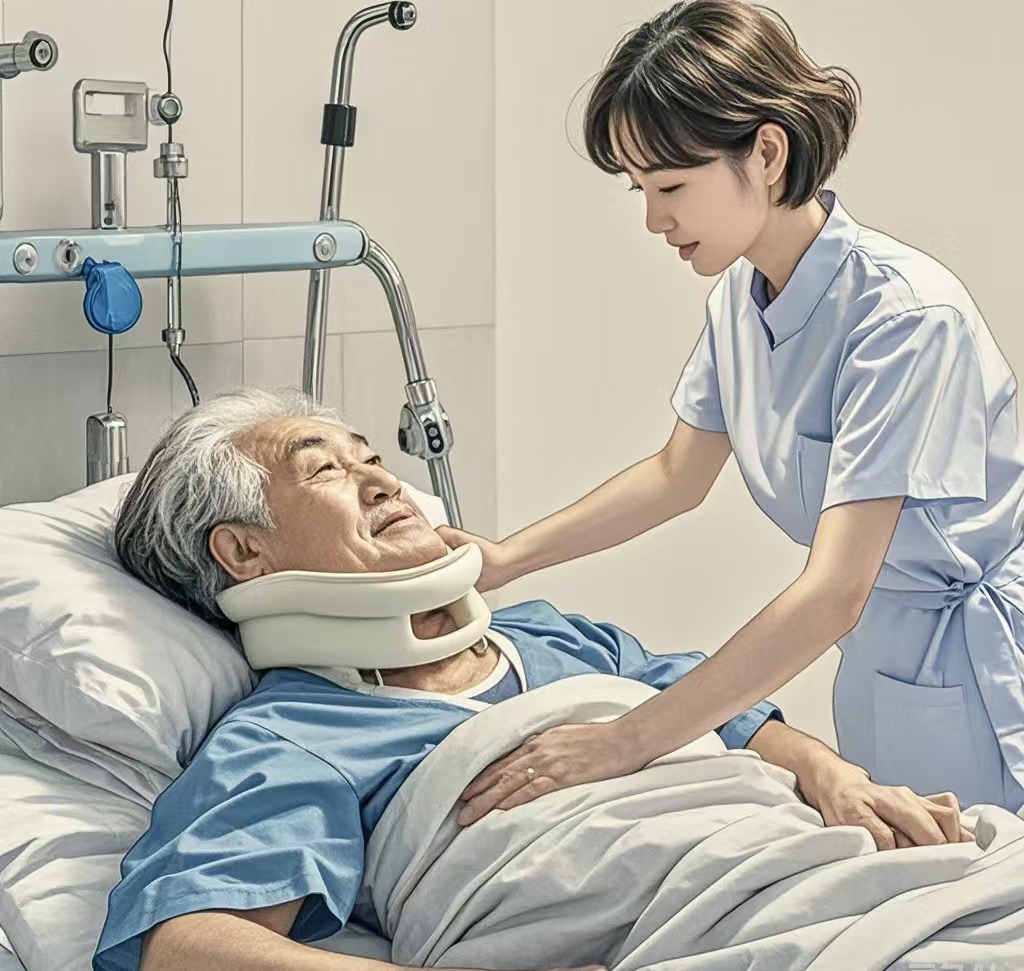Lao Kang, a middle-aged man rendered quadriplegic by a traumatic cervical spinal cord injury, arrived at our department two months post-surgery. Having endured complex surgical interventions, severe pulmonary infections, and early rehabilitation, he faced us with a voice strained by a tracheotomy tube and tears often silently streaming down his cheeks. His prolonged immobility had led to severe muscle atrophy in all four limbs, limiting his movement to a slight shrug of his shoulders. Breathing was shallow and rapid. Due to bowel and bladder dysfunction, he required intermittent catheterization and assistance with defecation. The challenges of daily care and rehabilitation were immense.
Standing steadfast by his bedside day and night was Xiao Kang, his 21-year-old daughter—a petite girl, barely 1.5 meters tall, with a face still bearing the traces of youth. Could this faint young woman shoulder such an arduous caregiving burden? With a sunny smile, she reassured us, “Doctor, don’t worry. I may be young, but I’m “strong”. I’ll leave my father’s rehabilitation training in your capable hands!”
In front of her father, Xiao Kang always maintained a brave facade, never shedding tears. Perhaps she wanted her optimism to soothe his pain. But I knew how deeply she hurt him. Whenever we discussed her father’s condition, she listened attentively, her unwavering gaze and determined words tinged with glimmers of unshed tears. At an age when she should have been carefree and playful, Xiao Kang had taken on the weight of her family, carrying life’s burdens with quiet resilience.
Rehabilitation for traumatic cervical burst fractures causing quadriplegia is a long and arduous journey. Given the severity of Lao Kang’s spinal cord injury, restoring his motor functions would be exceedingly difficult. However, we prioritized respiratory rehabilitation, as pulmonary infections and respiratory failure are the leading causes of early death in such cases. Lao Kang’s long history of smoking, compounded by respiratory muscle weakness and severe obstructive sleep apnea, made this even more urgent. Xiao Kang accompanied her father through every step of treatment—postural drainage, vibration therapy, respiratory rehabilitation techniques, and phrenic nerve stimulation.
She told me how her alarm clock rang every two hours, day and night, to remind her to turn her father over and perform chest percussion. Passing by their room, I often saw her slight figure turning her father, a man as solid as a mountain, and tapping his back with all her might. Her small frame seemed to contain boundless strength. Each strike of her hand not only cleared his lungs but also resonated in Lao Kang’s heart. Gradually, his respiratory function improved, his symptoms of breathlessness eased, and he began to engage in halting yet eager conversations with us, even managing to smile more often.

Xiao Kang told me about their life. Her father, a herdsman, was injured after falling from a straw stack just before lunch one day. The injury turned out far worse than anyone had imagined. At home, her mother and younger brother waited anxiously. Their modest means meant Xiao Kang had been working since a young age to support the family. Unable to afford a caregiver, she took on the responsibility of caring for her father herself. She also felt her presence was vital for his emotional well-being—no one else could bring him the same sense of reassurance.
After a period of rehabilitation, Lao Kang’s condition improved to the point where his tracheostomy tube could be capped, though he still lacked the strength to clear his airway and thus couldn’t have the tube removed entirely. With the help of Xiao Kang and our therapists, he could transfer to a wheelchair and take short outings. Despite the severity of his injury limiting his prognosis, we focused on maximizing his functional recovery. For the first time, I deeply felt the limits of medicine and the helplessness it sometimes entails.
During every ward round, I made it a point to teach Xiao Kang essential caregiving skills, precautions, and rehabilitation techniques. I didn’t want a minor complication to worsen their situation after discharge. Lao Kang and Xiao Kang expressed their gratitude for our care. Watching Lao Kang’s complexion grow healthier and seeing him actively cooperate in rehabilitation, supported tirelessly by Xiao Kang, left me with a mix of emotions. This young woman, forced to mature overnight by her father’s condition, embodied a resilience that was both heartbreaking and inspiring.
Soon, their hospital stay came to an end. Before leaving, Lao Kang had someone send apricots and almonds from their hometown as tokens of gratitude. The almonds, though bitter to taste, carried a rich and fragrant aroma.
Medicine has its limits, but compassion is boundless. As a doctor, my role is sometimes to cure, often to help, and always to comfort. I strive to bring a breath of spring and a ray of sunlight to families enduring profound suffering, offering them hope and the will to persevere, like the tenacious blades of grass that find ways to thrive.
Department of Rehabilitation Medicine,XiaoXue Zhai
